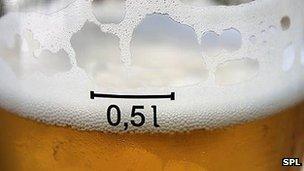Traffic-light blood test shows hidden alcohol harm
- Published

Repeated exposure to alcohol can scar the liver
A traffic-light colour-coded blood test can reveal hidden liver damage caused by drinking above recommended alcohol limits, say experts.
The UK doctors who devised the test say anyone who regularly drinks more than three or four bottles of wine a week, for example, is at significant risk.
Ultimately, GPs could offer the test to patients, especially since many people do not recognise unsafe drinking.
Often damage is only noticed at a late stage as the liver starts to fail.
Although the liver can heal itself to some extent, repeated onslaught will cause irreparable damage.
By the time the patient reaches hospital, the liver can be very scarred. And even when they stop drinking entirely, in many cases it is too late and they will die of liver complications over the next 12 months.
The traffic-light test can give an early colour-coded warning - green means damage is unlikely, amber means there is a 50:50 chance it is there, and red means the liver is most probably damaged and potentially irreversibly.
It combines a routine liver test doctors already use with two others that measure the level of scarring, also known as fibrosis.
Tried and tested
To try it out, the University of Southampton researchers tested more than 1,000 patients at their liver clinic.
This revealed that the traffic-light test was also good at predicting the prognosis of liver disease. Half of the liver patients had a red traffic light and (of a subset of these who were followed up) about a quarter died over the next five years, whereas none of the patients with a green test died or developed complications.
The findings are published in the British Journal of General Practice, external.
Dr Sheron's team have also been investigating how the test can be used in primary care.
Preliminary results in about 400 hazardous drinkers from 10 GP surgeries suggest many patients are willing to be tested and that learning the result can change behaviour.
A third of those given a green result cut down on their alcohol intake, while more than two-thirds of those given a red or amber result subsequently drank less.
Dr Nick Sheron, who devised the test, said: "It is a powerful tool and message for people. We can say, 'Amber means we can't be absolutely sure but there is at least a 50:50 chance that you have a scarred liver, and there is a significant possibility that you could die of it within 5 years'.
"We find that for most patients this is a pretty good stimulus to stop drinking or at least to cut down to safe levels."
He said, generally, people were receptive to being tested.
"People are immensely curious about if their alcohol intake is doing any harm. They want to take the test."
As well as people who drink more than the recommended amount, people who drink and are overweight or have type-two diabetes should consider getting tested, says Dr Sheron. This is because they are at increased risk of liver damage.
The Department of Health says men should not regularly drink more than three to four units of alcohol a day and women should not regularly drink more than two to three units a day.
"Regularly" means drinking every day or most days of the week. And if you do drink more heavily than this on any day, allow 48 alcohol-free hours afterwards to let your body recover.
The Royal College of Physicians (RCP) advises no more than 21 units per week for men and 14 units per week for women. But also, have two to three alcohol-free days a week to allow the liver time to recover after drinking anything but the smallest amount of alcohol.
There are one and a half units of alcohol in a small glass (125 ml) of ordinary strength wine (12% alcohol by volume) or a standard pub measure (35 ml) of spirits (40% alcohol by volume).
Estimates suggest 10 million or one in five adults in England drink above recommended levels.
Prof Sir Ian Gilmore, chair of the Alcohol Health Alliance, said: "One of the challenges of liver disease, which is rising dramatically in this country, is the silent nature of the condition until it is often too late to reverse the damage.
"However minor changes in standard liver blood tests are so common that it is difficult for GPs to know when to refer for specialist advice.
"This large study from Sheron and colleagues in Southampton may prove really useful for guiding the right patients towards specialist care in a timely way."
Andrew Langford of the British Liver Trust said: "If we are to make an in-road in reducing liver deaths - the only big killer increasing year on year - we have to make it easier for primary care to better understand the management of liver conditions as well as spotting the signs early."
- Published29 August 2012
- Published20 February 2012
- Published21 February 2011
- Published8 March 2012